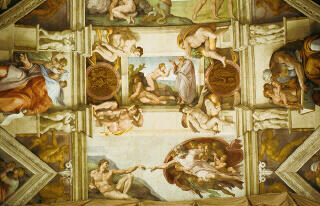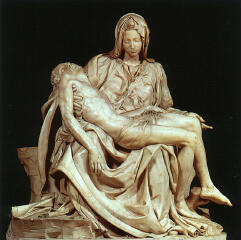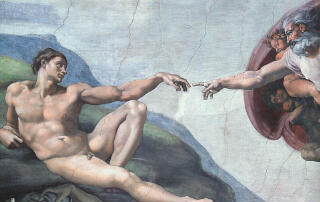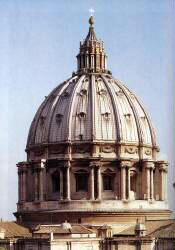
 Michelangelo
Michelangelo

He was born March 6, 1475, in the small village of Caprese near Florence. He spent the greater part of his adulthood in Rome, employed by the popes, however, he left instructions that he be buried in Florence, and his body was placed there in a fine monument in the church of Santa Croce.
Michelangelo went to Rome about 1495, where he was able to examine many newly unearthed classical statues and ruins. He soon produced his first large-scale sculpture, the over-life-size Bacchus.
At about the same time, Michelangelo also did the marble Piet� (1498-1500), still in its original place in Saint Peter's Basilica. One of the most famous works of art, the Piet� was probably finished before Michelangelo was 25 years old, and it is the only work he ever signed. The youthful Mary is shown seated majestically, holding the dead Christ across her lap.
 The high point of Michelangelo's early style is the gigantic (4.34 m/14.24 ft) marble David (Accademia, Florence), which he produced between 1501 and 1504, after returning to Florence.
The high point of Michelangelo's early style is the gigantic (4.34 m/14.24 ft) marble David (Accademia, Florence), which he produced between 1501 and 1504, after returning to Florence.
 The Sistine Chapel Ceiling
The Sistine Chapel Ceiling
Michelangelo was recalled to Rome by Pope Julius II in 1505 for two commissions. The most important one was for the frescoes of the Sistine Chapel ceiling. Working high above the chapel floor, lying on his back on scaffolding, Michelangelo painted, between 1508 and 1512, some of the finest images of all time. On the vault of the papal chapel, he devised an intricate system of decoration that included nine scenes from the Book of Genesis, beginning with God Separating Light from Darkness and including the Creation of Adam, the Creation of Eve, the Temptation and Fall of Adam and Eve, and the Flood. These centrally located narratives are surrounded by alternating images of prophets and sibyls on marble thrones, by other Old Testament subjects, and by the ancestors of Christ. In order to prepare for this enormous work, Michelangelo drew numerous figure studies and cartoons, devising scores of figure types and poses. These awesome, mighty images, demonstrating Michelangelo's masterly understanding of human anatomy and movement, changed the course of painting in the West.
 The Tomb of Julius II
The Tomb of Julius II
Before the assignment of the Sistine ceiling in 1505, Michelangelo had been commissioned by Julius II to produce his tomb, which was planned to be the most magnificent of Christian times. It was to be located in the new Basilica of St. Peter's, then under construction. Michelangelo enthusiastically went ahead with this challenging project, which was to include more than 40 figures, spending months in the quarries to obtain the necessary Carrara marble. Due to a mounting shortage of money, however, the pope ordered him to put aside the tomb project in favor of painting the Sistine ceiling. When Michelangelo went back to work on the tomb, he redesigned it on a much more modest scale.
The Last Judgment
In Rome, in 1536, Michelangelo was at work on the Last Judgment for the alter wall of the Sistine Chapel, which he finished in 1541. The largest fresco of the Renaissance, it depicts Judgment Day. Michelangelo painted his own image in the flayed skin of St. Bartholomew. Although he was also given another painting commission, the decoration of the Pauline Chapel in the 1540s, his main energies were directed toward architecture during this phase of his life.
 Dome of St. Peter's Basilica
Dome of St. Peter's Basilica
Michelangelo's crowning achievement as an architect was his work at St. Peter's Basilica, where he was made chief architect in 1546. The building was being constructed according to Donato Bramante's plan, but Michelangelo ultimately became responsible for the altar end of the building on the exterior and for the final form of its dome.
His dome for St. Peter's became the symbol of authority, as well as the model, for domes all over the Western world; the majority of state capitol buildings in the U.S., as well as the Capitol in Washington, D.C., are derived from it.
 Ret
Ret